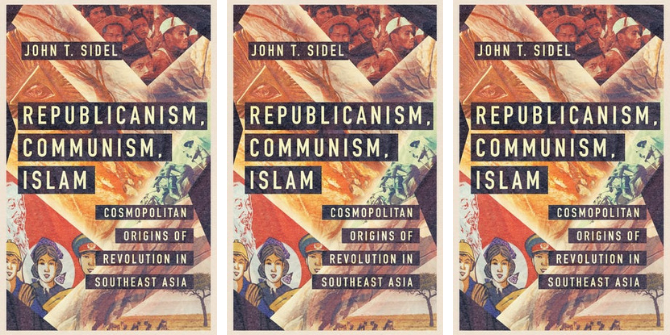In Diasporic Cold Warriors: Nationalist China, Anticommunism, and the Philippine Chinese, 1930s-1970s, Chien-Wen Kung explains how the Chinese Nationalist Party (Kuomintang) sowed the seeds of anticommunism among the Philippine Chinese with the active participation of the Philippine state during the Cold War. This is a well-researched and absorbing historical account, finds Luis Zuriel P. Domingo, and is an ideal addition to the growing literature on Cold War Southeast Asia.
This book review is published by the LSE Southeast Asia blog and LSE Review of Books blog as part of a collaborative series focusing on timely and important social science books from and about Southeast Asia.
Diasporic Cold Warriors: Nationalist China, Anticommunism, and the Philippine Chinese, 1930s-1970s. Chien-Wen Kung. Cornell University Press. 2022.
 The Chinese have always been part of the history of the Philippines. Even before the advent of European colonisation in Southeast Asia, the Chinese had established contact with the precolonial natives of the present-day Philippines, engaging in trade. Today, the Chinese in the Philippines, or the ‘Chinese Filipinos’, ‘Philippine Chinese’ or ‘Chinoys’, still play a significant role in Philippine society, but mainly in the business sector. Chien-Wen Kung’s Diasporic Cold Warriors, however, recounts a fragment of Chinese and Philippine histories that may have long been forgotten in the archives, even reduced to a mere footnote.
The Chinese have always been part of the history of the Philippines. Even before the advent of European colonisation in Southeast Asia, the Chinese had established contact with the precolonial natives of the present-day Philippines, engaging in trade. Today, the Chinese in the Philippines, or the ‘Chinese Filipinos’, ‘Philippine Chinese’ or ‘Chinoys’, still play a significant role in Philippine society, but mainly in the business sector. Chien-Wen Kung’s Diasporic Cold Warriors, however, recounts a fragment of Chinese and Philippine histories that may have long been forgotten in the archives, even reduced to a mere footnote.
Based on the title itself, Diasporic Cold Warriors gives the readers a hint about the focus of the book: diaspora and the Cold War. At first, Chien-Wen Kung’s choice of the Philippine Chinese is somehow intriguing. The Chinese community in the Philippines was one of the smallest in Southeast Asia, yet, according to Chien-Wen Kung, ‘were the world’s most exemplary Cold Warriors’ (1). Thus, the book’s main objective is to examine the role of the Philippine Chinese in fighting Sino-communism as part of the Kuomintang (KMT) and the Philippine government’s joint anticommunism responsibility in the Cold War. In other words, Diasporic Cold Warriors embarks on discussing a Cold War story away from the usual narrative under the umbrella of the United States. Chien-Wen Kung calls his framework the ‘intra-Asian anticommunist ecumene’ where two Asian countries — in this case, the Philippines and the Republic of China (ROC) — collaborated on a particular goal that aided in solving each of their objectives.
The book is written according to chronological sequencing that includes an introduction that sets out to explain the zeitgeist and direction of the study; seven chapters that tackle different stories of the Philippine Chinese and the KMT’s adventure in the Philippines from pre-war to post-war periods; and a culminating chapter at the end. While the book’s coverage is from the 1930s to the 1970s, Chien-Wen Kung successfully weaves the narratives, giving both a magnified and a bird’s eye view of these diasporic Cold Warriors.
For me, a couple of major points will interest the readers of Diasporic Cold Warriors. First is the added understanding of the larger role of the Chinese community in the Philippines in terms of transnational or overseas politics. It is interesting to know about the existence of this so-called ‘shared sovereignty’ between the two countries: how the Philippines let the KMT operate locally, overlapping or bypassing Philippine sovereignty for the cause of anticommunism (69).
Second, the book shows and gives more nuance to the Philippines’ paranoia about communism which the Philippine Chinese, either directly involved with the KMT or not, took advantage of because of personal motivation and, in part, to favour their interests (89). At one point, Chien-Wen Kung also narrates that naivety and youthfulness, as best seen in the Cebu reading club, revealed the reactionary extent of combatting the Red Menace (118). Opportunism and triviality led to massive intelligence failures, almost loosely carried out by Philippine military intelligence, that only exposed the nature of such inept obsession.
Third, and last, is the conflicting interests of Chinese and Filipino nationalisms. At this stage of the post-colony, on the one hand the Philippine nation remained entangled in the vestiges of colonialism and at the birth pangs of developing its own international identity and personality. On the other hand, the ROC was on a course to preserve its ‘Chineseness’ and its Republican era-guiding ideologies, specifically in the diaspora (179).
Chien-Wen Kung ends the book in a dramatic fashion. When the Philippines recognised the legitimacy of the People’s Republic of China (PRC) and the eventual Filipinisation of Chinese schools because of the Marcosian nationalist fantasy in the 1970s, the KMT’s authority overseas weakened and brought an end ‘to the Cold War for the Philippine Chinese and the Philippine KMT’ (214). Since then, this array of stories would be shelved until the publication of Diasporic Cold Warriors. And the Philippine Chinese, from the eyes of the Filipino public since then, would be dragged on the radar of the PRC. For instance, a controversial racist affair that the late Filipino National Artist for Literature F. Sionil José caused in 2015 when he questioned the allegiance, and what he believed to be an encroachment, of the ‘ethnic Chinese’ in the country, only to spill sweeping generalisations about the Philippine Chinese community. Perhaps, hypothetically, José would have thought twice about causing such a blunder if only he had read Chien-Wen Kung’s rediscovery of the political history of the Philippine Chinese during the Cold War.
Chien-Wen Kung’s attempt is successful, particularly in establishing new research directions in the study of modern history in Asia. The party-state relationship of the KMT and ROC can also be understood through the lens of diaspora. The shared sovereignty of the Philippines and the ROC, bolstering their efforts in the region, in some way prevented the Chinese left from advancing their interests in the Philippines. A win-win solution not only for both nations but also for the larger global anticommunist crusade. Yet, the concept of ‘intra-Asian anticommunist ecumene’ gives the impression that the history of the Cold War can be written in the absence of the American empire, a breakaway from the usual Cold War containment narrative in Southeast Asia.
Diasporic Cold Warriors, in conclusion, contends that the Philippine Chinese, as an ethnic minority in the Philippines, did embrace the KMT-ROC’s anticommunism ideology as means to assimilate themselves or to show validation that they could be part of the larger Philippine society.
Overall, I consider the book not only about the history of the ROC in the Philippines but also an important part of Philippine history during the Cold War. The adventures of the KMT, and its adherents, in the country would not be operative without the involvement of the Philippine government on the sidelines. Diasporic Cold Warriors is a well-researched, well-written and absorbing historical work. Despite the bounteous information that will surely be enjoyed by modern China scholars, Southeast Asianists and historians alike, Chien-Wen Kung does not drift away from his narration and argumentation, making the book even suited for newcomers and a decent read for undergraduates. I hope a local edition is in the works for this brilliant book as it will be essential reading for the larger Filipino community, especially for the Philippine Chinese. Indeed, Chien-Wen Kung’s Diasporic Cold Warriors is an ideal addition to the growing literature on diasporic Chinese political activities and Cold War Southeast Asia.
Note: This review gives the views of the author, and not the position of the LSE Review of Books blog, the LSE Southeast Asia blog or of the London School of Economics and Political Science.







